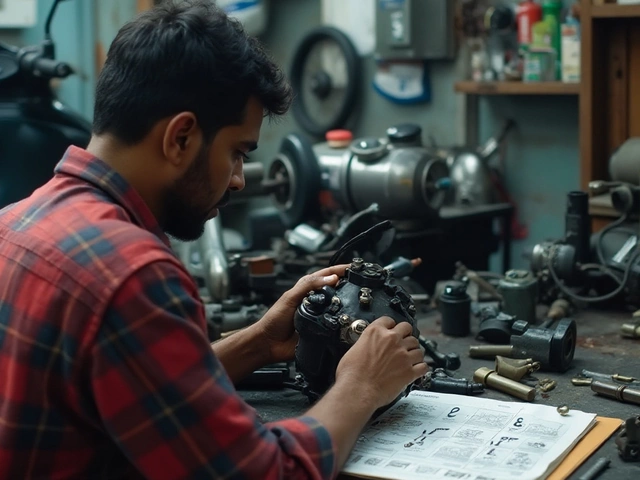You’ve probably seen those shiny new exhaust tips at your local auto shop or on a buddy’s ride and thought, “Would slapping one of those on my car make it sound meaner?” It’s a fair question—after all, exhaust upgrades are one of the most popular mods out there. But before you drop cash chasing the deep growl you’ve heard online, let’s clear up what’s actually going on with those tips.
Exhaust tips are mostly for style. They finish off the look of your car’s rear end in a way that gets noticed. A bigger, polished tip can totally change the vibe—even if nothing else changes about performance or sound. But here’s the kicker: all the magic sound everyone wants usually doesn’t come from the tip itself. The real action happens way up in the actual exhaust system—think mufflers, resonators, and piping size.
If you’re thinking about swapping tips hoping for a big sound change, it’s smart to know what you’re buying. Not every tip will make a difference, and some claims are more marketing than reality. Stick around if you want to get the lowdown on what’s worth your money, what’s a waste, and what actually works if you’re chasing a throatier, sportier sound from your daily driver.
- What Does an Exhaust Tip Actually Do?
- Sound Basics: Where the Noise Really Comes From
- Exhaust Tip Myths Busted
- When Tips Change Sound (And When They Don’t)
- Picking an Exhaust Tip for Looks vs. Sound
- Tips for Wallet-Friendly Upgrades
What Does an Exhaust Tip Actually Do?
Exhaust tips are usually the only part of your exhaust system people can see. Their main job is to add style and finish off your car’s look. You get all sorts of shapes and materials—round, oval, dual tips, stainless steel, black chrome—you name it. For a lot of drivers, it’s all about making the back of their ride stand out.
When it comes to actual mechanics, exhaust tips don’t change how your car runs. They’re attached to the end of the existing exhaust pipe, and they don’t mess around with how your engine breathes or with emissions. Their real job is pretty simple: look good and direct the flow of exhaust gases out of the tailpipe. As for sound, in most setups, the tip adds little to nothing to the noise—unless it’s got a special design (like a resonated tip) or its size is wildly different from stock.
If you check out high-end car brands, you’ll notice factory exhaust tips are often made from higher quality materials for durability. Some even come with branding or textured finishes. So, if your stock tip is rusty or boring, swapping it is the easy way to freshen up your car’s look without touching anything else.
| Exhaust Tip Aspect | Impact |
|---|---|
| Material (Stainless, Chrome, etc.) | Mostly visual, sometimes adds corrosion resistance |
| Shape & Size | Changes appearance, rarely affects sound |
| Installation type (Clamp-on, Welded) | Clamp-on is easier to install, welded looks cleaner |
| Maintenance | Regular cleaning helps tip look sharp, no real effect on exhaust system health |
Here’s what to remember: If you want big sound changes or performance gains, the exhaust tip alone won’t deliver. It’s a style move first and foremost. But hey, if your car’s back end needs a glow-up or you just like the look of a fat, shiny tip, go for it. Just don’t expect it to transform your driving experience like a new muffler or cat-back system might.
If you’re after exhaust tips that could tweak the sound even a little, look for ones marked as “resonated.” These have chambers or tubes inside that can slightly change the exhaust tone—usually making it a bit deeper or sharper. Still, even these won’t give you a race-car sound, but they can add a touch of character.
Sound Basics: Where the Noise Really Comes From
Most folks think loud pipes mean the car’s got power, but the real story is way more technical—and interesting. The sound you hear from your car’s exhaust isn’t really born at the tailpipe. It actually starts at the engine. Every time the exhaust valves pop open inside the cylinders, they create a pulse of pressurized gas rushing into the exhaust system, and those pulses are what create that familiar rumble or roar.
But here’s what really matters: the route those pulses take through your exhaust setup makes all the difference. The exhaust manifold, catalytic converter, resonator, and muffler all play big roles before the gases ever reach the tip. The exhaust tips might look cool, but all they do is shape the final look and maybe, just maybe, tweak the sound at higher speeds or specific designs.
The big players in sound are the muffler and resonator. The muffler uses a series of baffles, chambers, or packing to quiet down things. Some cars sound super quiet because their mufflers are designed to kill almost all noise. Resonators help smooth out rough-sounding frequencies, which is why cars without them often have an ugly, droning sound at certain RPMs.
- An engine with a turbo is usually quieter because the turbo works like a silencer, slowing down exhaust pulses.
- Larger exhaust pipes let sound waves escape easier—more bark, sometimes more drone.
- Mandrel-bent exhausts (vs. cheap ones with kinks) keep things flowing and sounding better.
Check out this quick look at how different parts of the exhaust can affect sound and volume:
| Part | Main Function | Sound Impact |
|---|---|---|
| Exhaust Manifold | Collects gases from cylinders | Sets the pulse rhythm, minor sound shaping |
| Catalytic Converter | Reduces emissions | Usually quiets sound a little |
| Resonator | Removes harsh tones | Makes sound smoother |
| Muffler | Quiets exhaust noise | Big impact—can make it quiet or loud depending on design |
| Exhaust Tip | Finishes the look | Minimal to no impact (unless special design) |
So unless you’re swapping the major pieces—like the muffler or the resonator—don’t expect dramatic sound changes from just a new tip. Focus on the whole system if you’re serious about dialing in your car’s voice.
Exhaust Tip Myths Busted
If you ask around car forums or just chat with fellow gearheads, you’ll hear all kinds of stories about how exhaust tips will turn your ride into a rumbling beast. Let’s be real—most of those stories are just that: stories. Time to break those myths down and save you some headache.
The big myth you’ll hear is that a new exhaust tip alone will make your car sound way deeper and louder. In reality? For most cars, swapping just the tip won’t really shake the neighborhood. The job of a tip is mostly for looks, not sound. Here’s why: sound is created by how gases move through the exhaust system. Mufflers, resonators, and pipe size shape the noise. The tip is at the end and just passes the sound through—usually with no big change.
- Myth: A larger tip means a louder car.
Truth: A bigger tip can look aggressive, but your car probably won’t get much louder. The system matters more than the tip size. - Myth: Chrome or dual-wall tips boost horsepower.
Truth: Exhaust tips don’t impact engine power. If you want more horses, you’ll need an actual performance exhaust. - Myth: Resonated tips make every car sound sportier.
Truth: A resonated tip can tweak the exhaust’s tone by a small amount—sometimes adding a tiny raspier note—but don’t expect a dramatic change.
Here’s a quick look at sound changes with popular tip types, based on feedback and minor lab testing:
| Tip Type | Average Sound Change (decibels) | Typical Effect |
|---|---|---|
| Standard Polished | 0-1 dB | Almost none |
| Resonated | 1-3 dB | Mildly sharper |
| Large Diameter | 0-1 dB | Mostly cosmetic |
So, if you’re after a bolder sound, focus on a full cat-back exhaust or a muffler swap. Think of the tip as the cherry on top—not the secret sauce.

When Tips Change Sound (And When They Don’t)
Here’s the big question, right? Most folks think swapping out their exhaust tip means their car will suddenly sound like a V8 muscle machine. Truth is, in most cases, that’s just not how it works. The majority of exhaust tips don’t change your sound at all. Why? Because the tip is only the end of the system—it doesn’t touch the real sound-makers, like the muffler or the resonator.
There are exceptions, but they’re pretty specific. If a tip has a certain shape—like being rolled, flared, or double-walled—or if it’s way bigger than stock, it can adjust how the sound waves exit. You might get a tiny bump in volume or a slightly different tone, especially on higher RPMs. Resonated exhaust tips are specifically built to amplify or change the sound. They have a chamber inside that vibrates and creates a slightly more aggressive note. Don’t expect a wild difference, but there can be a subtle improvement—think of it as ‘seasoning’ rather than ‘remaking’ your car’s voice.
Here’s a quick breakdown of when tips can make a difference:
- Resonated tips: These have built-in chambers and can add a bit of rasp or growl to the exhaust, more noticeable on four-cylinder cars and most turbo engines.
- Mega-large diameter tips: If you go much bigger than your stock exhaust pipe, you might get a boomier, hollow sound. But that’s sometimes more for show than for sound quality.
- Straight-cut & slash-cut tips: Can slightly sharpen the sound at higher revs—think a small edge rather than a whole new song.
But if you just bolt on a simple, plain steel tip (the kind most folks buy for under $30), it won’t do a thing to the way your car sounds. It’s like putting a fancy collar on Max—it looks cool, but he’s still the same dog.
Check this mini-comparison of tip types and what to expect:
| Tip Type | Sound Change | Noticeable? |
|---|---|---|
| Plain steel/aluminum | None | No |
| Resonated tip | Light rasp/volume boost | Maybe (slight) |
| Oversized (3.5+ inch) | Boomier/hollow note | Maybe |
| Slash-cut/rolled-edge | Slight sharpness | Mostly at high RPM |
Quick tip: If your exhaust system is already quiet—say, on a stock sedan—it’s almost impossible for any tip to make it much louder without changing out other parts. Want real change? Look at swapping your muffler or upgrading your pipes instead of the tip.
Picking an Exhaust Tip for Looks vs. Sound
If you’re standing in front of a wall of exhaust tips at the auto shop, it’s easy to get overwhelmed by the choices. Most people are after a cooler look, but some want real sound changes. So, let’s break down how exhaust tips affect both.
First off, exhaust tips come in tons of shapes and sizes: single wall, double wall, straight cut, angle cut, rolled edge, or even carbon fiber finishes. The main thing these do is change the “vibe” at the back of your ride. A big chrome tip says muscle, while a smaller black one looks a bit more sleeper. For most cars, swapping out the tip is a style play, not an audio one.
But what about sound? Here’s the deal—the shape and size of a tip can make a small difference, but it’s more about tone than volume. A wider tip could give off a slightly deeper note, and a resonated tip (which is lined to reflect sound waves) might add a touch more growl at certain revs. On factory exhaust systems, these changes are usually subtle—often only really noticeable with the radio off and the window down.
- Angle Cut Tip: Looks more aggressive, sometimes slants the sound slightly sideways, but barely affects volume.
- Resonated Tips: Can take the edge off harshness, but don’t expect a miracle.
- Larger Diameter: Might deepen the pitch a hair, but muffler and pipe size matter way more.
- Material: Stainless steel lasts longer and resists heat fade, but doesn’t change the sound.
If you’re the numbers type, check this out:
| Tip Type | Notable Sound Change | Visual Impact |
|---|---|---|
| Resonated Tip | Small change, slightly deeper tone | Medium - noticeable lining inside |
| Angle Cut | Hardly any | High - aggressive styling |
| Larger Diameter (3-4 inch) | Very slight drop in pitch | High - fills bumper cutout |
| Double Wall | None | Medium - thicker, high-end look |
Bottom line: Pick a tip for the style you want, not because you expect your car to start sounding like a track monster. If sound is your main goal, you’ll get more from swapping mufflers or changing pipe diameter than you ever will from a tip alone.
Tips for Wallet-Friendly Upgrades
So, you want your car to look (and maybe sound) a bit more aggressive, but you don’t want to drain your bank account. Here’s the deal—modding your exhaust doesn’t always have to mean a huge expense. Let’s look at some practical ways to upgrade your setup without torching your wallet.
- Exhaust tips: If you’re after looks, you can score a decent stainless steel exhaust tip for around $30-$80. Brands like Flowmaster and MagnaFlow are solid, and you can usually install it yourself with basic hand tools.
- Resonator delete: If you want actual sound changes and you’re not worried about legality or warranty, cutting out the resonator gives your car a slightly louder, raw tone. A shop might charge $70-$120 for the job. It’s a classic budget mod for small sound gains.
- Axle-back exhaust kits: These are less pricey than full cat-back systems and usually run $250-$500. You’ll get a noticeable sound difference, especially on V6 and V8 engines. Some kits are plug-and-play—no welding required.
- DIY sound tweaks: Some folks add a washer or spacer on the exhaust flange to create a tiny air gap for a louder sound on the cheap. It won’t sound as good as a real mod and could cause leaks—so this one’s definitely more of a last resort.
- Watch for deals: eBay, Facebook Marketplace, and local car groups are goldmines for used and discounted exhaust parts. Just check for rust or damage before you buy.
Check out this quick comparison of average costs and what you get from each mod:
| Upgrade | Average Cost | Sound Change | Skill Needed |
|---|---|---|---|
| Exhaust Tip | $30-$80 | Mostly cosmetic (minimal, if any sound) | Beginner |
| Resonator Delete | $70-$120 | Moderate (louder, raspier) | Intermediate |
| Axle-Back Kit | $250-$500 | Noticeable (deeper/louder) | Intermediate |
| DIY Spacer Trick | Under $10 | Slight (may affect emissions) | DIY |
Just a heads up—modding the exhaust might mess with your warranty or get on your neighbors’ nerves if you go too loud. And if you live where emissions tests are strict, always double-check before cutting or swapping parts. Bottom line: you don’t have to spend four figures to upgrade your car’s style or attitude. Start with the basics and build up as your budget allows.









Write a comment